
Bromus ramosus, the hairy brome, is a bunchgrass in the grass family Poaceae, native to Europe, northwest Africa and southwest Asia. The name Bromus comes from the term brome, meaning oats. Unlike most other bromes, it grows in shady sites under trees.

Bromus arvensis, the field brome, is a brome grass native to Europe and Asia. The specific epithet arvensis is Latin, meaning "of cultivated land".

Brachypodium sylvaticum, commonly known as false-brome, slender false brome or wood false brome, is a perennial grass native to Europe, Asia and Africa. It has a broad native range stretching from North Africa to Eurasia.

A foxtail is a spikelet or cluster of a grass, that serves to disperse its seeds as a unit. Thus, the foxtail is a type of diaspore or plant dispersal unit. Some grasses that produce a foxtail are themselves called "foxtail", also "spear grass". They can become a health hazard for dogs and other domestic animals, and a nuisance for people.

Bromus hordeaceus, the soft brome, is an annual or biennial species of grass in the true grass family (Poaceae). It is also known in North America as bull grass, soft cheat, and soft chess.
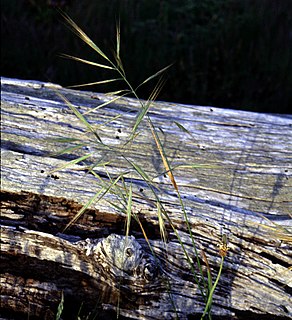
Bromus diandrus is a species of grass known by the common names great brome and "ripgut brome".

Bromus interruptus, commonly known as the interrupted brome, is a flowering plant in the grass family. It is endemic to southern and central England, which became extinct in the wild in 1972. After several decades in cultivation, the interrupted brome was re-introduced to Aston Rowant National Nature Reserve in 2004, marking the first known re-introduction of an extinct plant in Britain. The plant was a weed of waste places and arable agriculture, particularly of sainfoin cultivation. It can be distinguished from all other Bromus species by its deeply split, or bifid, palea.

Bromus secalinus is a species of bromegrass known as rye brome. The specific epithet secalinus is Latin, meaning "rye-like". The fruits are hard, rounded glumes that appear superficially similar to the rye grain, which gives the brome its common and scientific name. The grass has a diploid number of 28.

Bromus madritensis is a species of brome grass known by the common name compact brome. The specific epithet madritensis refers to Madrid, Spain. It has a diploid number of 28.
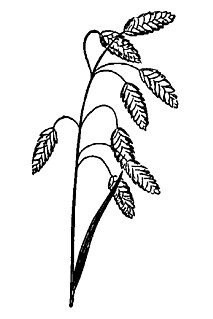
Bromus briziformis is a species of brome grass known by the common name rattlesnake brome. The specific epithet briziformis comes from the resemblance of the grass to grasses of the genus Briza, particularly Briza maxima. The common name is derived from the resemblance of the spikelets to the rattles of rattlesnakes. The grass has a diploid number of 14.
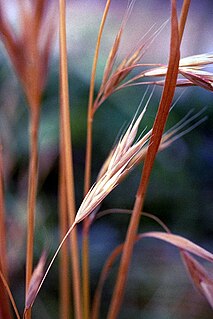
Bromus carinatus is a species of brome grass known by the common names California brome and mountain brome.

Bromus catharticus is a species of brome grass known by the common names rescuegrass, grazing brome, prairie grass, and Schrader's bromegrass. The specific epithet catharticus is Latin, meaning cathartic. The common name rescuegrass refers to the ability of the grass to provide forage after harsh droughts or severe winters. The grass has a diploid number of 42.

Bromus ciliatus is a species of brome grass known by the common name fringed brome. It is native to most of North America, including most of Canada, most of the United States except for some portions of the South, and northern Mexico. It is a plant of many habitats, including temperate coniferous forest. The specific epithet ciliatus is Latin for "ciliate", referring to the delicate hairs of the leaf blades.

Bromus grandis is a species of brome grass known by the common name tall brome.
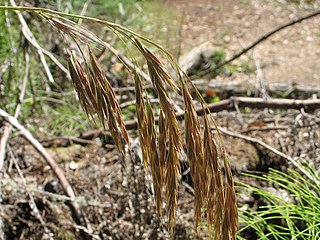
Bromus laevipes is a species of brome grass known by the common name Chinook brome.

Bromus orcuttianus is a species of brome grass known by the common name Orcutt's brome.

Bromus erectus, commonly known as erect brome, upright brome or meadow brome, is a dense, course, tufted perennial grass. It can grow to 120 centimetres (47 in). Like many brome grasses the plant is hairy. The specific epithet erectus is Latin, meaning "erect". The diploid number of the grass is 56.

Bromus nottowayanus, the Nottoway Valley brome or satin brome, is a brome grass native to North America. The specific epithet nottowayanus refers to the Nottoway Valley. The grass has a diploid number of 14.
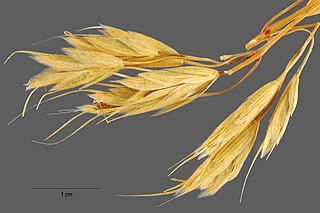
Bromus squarrosus, the rough brome, is a brome grass native to Russia and Europe. The specific epithet squarrosus is Latin, meaning "with spreading tips". The grass has a diploid number of 14.

Bromus rigidus, the ripgut brome, is a grass native to Eurasia and naturalized in North America. The specific epithet rigidus means rigid or stiff.




















